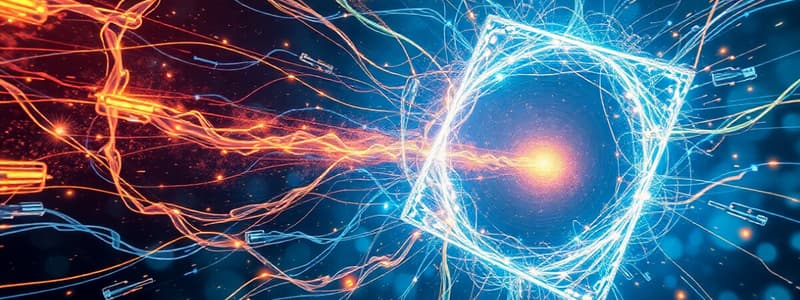Podcast
Questions and Answers
Which statement correctly describes momentum?
Which statement correctly describes momentum?
- It is a measure of an object's motion, dependent on mass and velocity. (correct)
- It only applies to objects at rest.
- It is always conserved in all interactions.
- It is directly proportional to the force applied to an object.
What does the first law of thermodynamics state?
What does the first law of thermodynamics state?
- Energy will always increase in an isolated system.
- Energy can neither be created nor destroyed, only transformed. (correct)
- The total energy in a closed system must remain constant.
- Energy can be created as long as it is transformed.
In Newton's second law of motion, which of the following is true about the relationship between force, mass, and acceleration?
In Newton's second law of motion, which of the following is true about the relationship between force, mass, and acceleration?
- Mass is directly proportional to the force applied.
- The acceleration increases with increasing force and decreases with increasing mass. (correct)
- Acceleration is independent of the mass of the object.
- Force is inversely proportional to mass.
What is the primary force that acts between two objects with mass?
What is the primary force that acts between two objects with mass?
Which statement best describes the second law of thermodynamics?
Which statement best describes the second law of thermodynamics?
According to Newton's third law of motion, what happens when one object exerts a force on another?
According to Newton's third law of motion, what happens when one object exerts a force on another?
What is the nature of heat transfer in thermodynamics?
What is the nature of heat transfer in thermodynamics?
What is a primary focus of classical mechanics?
What is a primary focus of classical mechanics?
What is the relationship defined by the uncertainty principle?
What is the relationship defined by the uncertainty principle?
Which of the following best describes wave-particle duality?
Which of the following best describes wave-particle duality?
What do electromagnetic waves consist of?
What do electromagnetic waves consist of?
In optics, what does refraction refer to?
In optics, what does refraction refer to?
Which of the following statements about general relativity is true?
Which of the following statements about general relativity is true?
What role do quantum numbers play in atomic structure?
What role do quantum numbers play in atomic structure?
What is the primary application of Maxwell's equations?
What is the primary application of Maxwell's equations?
Which of the following describes the concept of time dilation?
Which of the following describes the concept of time dilation?
How does dispersion of light occur?
How does dispersion of light occur?
Flashcards
Classical Mechanics
Classical Mechanics
The study of how macroscopic objects move under the influence of forces.
Force
Force
A push or pull that can change the motion of an object.
Mass
Mass
A measure of an object's resistance to changes in motion. The more massive an object, the harder it is to accelerate.
Acceleration
Acceleration
Signup and view all the flashcards
Momentum
Momentum
Signup and view all the flashcards
Energy
Energy
Signup and view all the flashcards
Thermodynamics
Thermodynamics
Signup and view all the flashcards
Temperature
Temperature
Signup and view all the flashcards
Quantization
Quantization
Signup and view all the flashcards
Wave-particle duality
Wave-particle duality
Signup and view all the flashcards
Uncertainty principle
Uncertainty principle
Signup and view all the flashcards
Wave functions
Wave functions
Signup and view all the flashcards
Quantum numbers
Quantum numbers
Signup and view all the flashcards
Electromagnetism
Electromagnetism
Signup and view all the flashcards
Electric fields
Electric fields
Signup and view all the flashcards
Magnetic fields
Magnetic fields
Signup and view all the flashcards
Electromagnetic waves
Electromagnetic waves
Signup and view all the flashcards
Special relativity
Special relativity
Signup and view all the flashcards
Study Notes
Classical Mechanics
- Classical mechanics describes the motion of macroscopic objects under the influence of forces.
- It is based on Newton's laws of motion, which relate force, mass, and acceleration.
- Key concepts include:
- Force: A push or pull that can change the motion of an object.
- Mass: A measure of an object's resistance to changes in motion.
- Acceleration: The rate at which an object's velocity changes.
- Momentum: A measure of an object's motion, related to its mass and velocity.
- Energy: The capacity to do work.
- Different types of force include:
- Gravitational force: An attractive force between any two objects with mass.
- Electromagnetic force: A force between charged particles.
- Strong nuclear force: A force that binds protons and neutrons in the nucleus.
- Weak nuclear force: A force involved in radioactive decay.
- Newton's laws of motion:
- First law (law of inertia): An object at rest stays at rest, and an object in motion stays in motion with the same speed and in the same direction unless acted upon by an unbalanced force.
- Second law (law of acceleration): The acceleration of an object is directly proportional to the net force acting on it and inversely proportional to its mass. This is often expressed as F = ma.
- Third law (law of action-reaction): For every action, there is an equal and opposite reaction.
- Applications of classical mechanics include:
- Calculating trajectories of projectiles
- Designing machines and structures
- Understanding planetary motion
Thermodynamics
- Thermodynamics deals with the relationships between heat, work, and energy.
- Key concepts include:
- Temperature: A measure of the average kinetic energy of the particles in a substance.
- Heat: A transfer of thermal energy between objects due to a temperature difference.
- Work: Transfer of energy by the application of force over a distance.
- Internal energy: The total energy of all the particles in a system.
- Laws of Thermodynamics:
- First law: Energy can neither be created nor destroyed, only transformed from one form to another.
- Second law: The total entropy of an isolated system can only increase over time. This dictates the direction of spontaneous processes.
- Third law: As the temperature of a system approaches absolute zero, the entropy of the system approaches a constant minimum value.
Quantum Mechanics
- Quantum mechanics describes the behavior of matter and energy at the atomic and subatomic levels.
- Key concepts:
- Quantization: Properties like energy and angular momentum are limited to discrete values.
- Wave-particle duality: Particles exhibit both wave-like and particle-like properties.
- Uncertainty principle: It is impossible to know precisely both the position and momentum of a particle simultaneously.
- Wave functions: Mathematical functions that describe the probability of finding a particle in a particular location.
- Quantum numbers: Determines the properties of an electron within an atom.
- Applications of quantum mechanics include:
- Understanding atomic structure and chemical bonding.
- Designing new materials with specific properties.
- Developing technologies like lasers and semiconductors.
- Modern electronics rely heavily upon quantum mechanics
Electromagnetism
- Electromagnetism describes the interaction between electric and magnetic fields.
- Key concepts include:
- Electric fields: Generated by charged particles.
- Magnetic fields: Generated by moving charged particles.
- Electromagnetic waves: Combination of oscillating electric and magnetic fields that travel through space at the speed of light.
- Maxwell's equations: Set of equations that describe the fundamental laws of electromagnetism.
- Electromagnetic spectrum includes a broad range of electromagnetic radiation, distinguished by frequency and wavelength.
- Applications of electromagnetism include:
- Generating and using electricity
- Transmission of information through radio waves, microwaves, and various forms of light.
- Modern communication systems, medical imaging, and a multitude of everyday technologies.
Optics
- Optics deals with the behavior and properties of light.
- Key concepts include:
- Reflection: Light bouncing off a surface.
- Refraction: Light bending as it passes from one medium to another.
- Dispersion: Separation of light into its constituent colors (spectrum).
- Interference: Superposition of waves, resulting in either reinforcement or cancellation of light.
- Diffraction: Bending of light waves around obstacles.
- Polarization: Light waves vibrating in a specific direction.
- Applications of optics include:
- Design of telescopes and microscopes
- Production of lenses and mirrors
- Optical fibers and communications
- Medical imaging techniques.
Relativity
- Relativity encompasses Einstein's theories of special and general relativity.
- Special relativity deals with the relationship between space and time for observers in uniform motion. Key concepts include:
- The speed of light is constant for all observers.
- Space and time are not absolute but interconnected as spacetime.
- Mass–energy equivalence (E = mc²).
- Time dilation and length contraction.
- General relativity deals with gravity as a curvature of spacetime caused by mass and energy. Key concepts include:
- Gravity is not a force, but a consequence of spacetime curvature.
- Orbits of planets are curved by the curvature of spacetime.
- Gravitational waves are ripples in spacetime.
- Applications include GPS technology, cosmology.
Studying That Suits You
Use AI to generate personalized quizzes and flashcards to suit your learning preferences.




